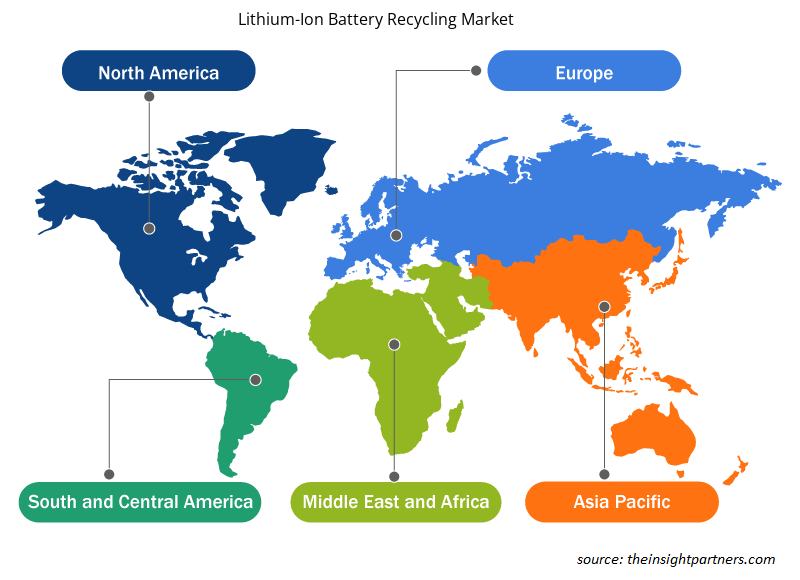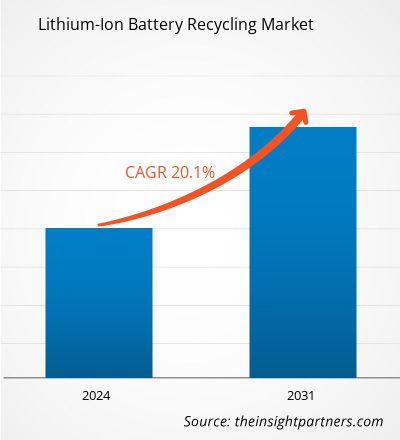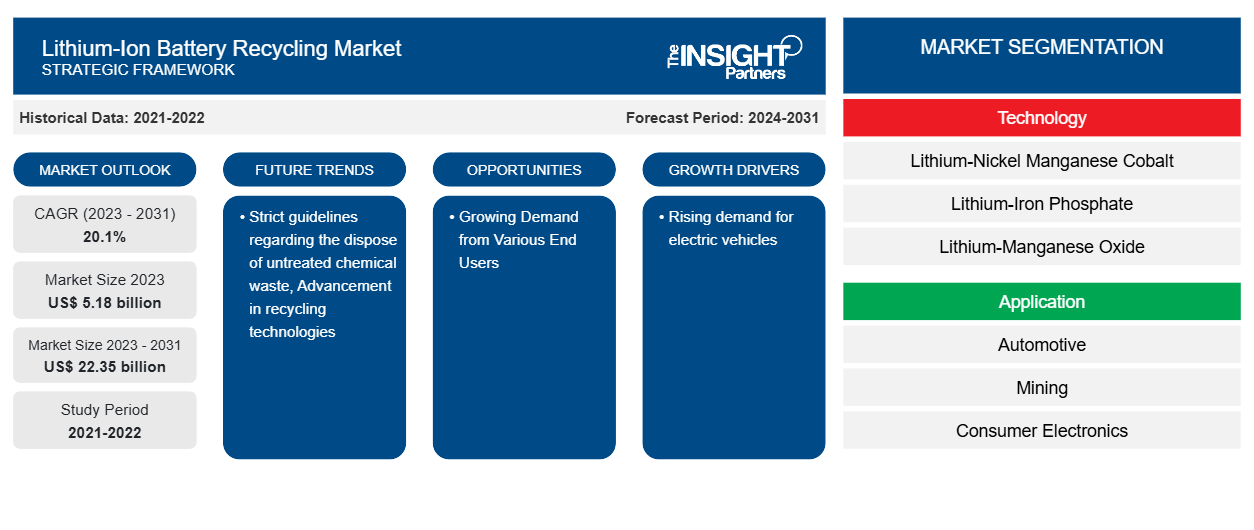リチウムイオン電池リサイクル市場規模は、2023年の51億8,000万米ドルから2031年には223億5,000万米ドルに拡大すると予想されており、2023年から2031年にかけて年平均成長率20.1%で成長すると予測されています。未処理の化学廃棄物の処分に関する厳格なガイドラインとリサイクル技術の進歩は、今後もリチウムイオン電池リサイクル市場の主要トレンドであり続けると思われます。
リチウムイオン電池リサイクル市場分析
自動車業界では近年、特に米国、ドイツ、スウェーデン、ノルウェー、オランダ、中国、および東南アジアのいくつかの発展途上国で、リサイクルされたリチウムイオン電池の需要が大幅に増加しています。IEAの報告によると、2020年と比較して、2021年の電気自動車の販売台数はほぼ2倍の660万台(約9%)となり、全体で1,650万台の電気自動車が路上を走行しています。さらに、IEAは2030年までに3億台を超える電気自動車が路上 を走行すると予測して おり、リチウムイオン電池のリサイクルが増加する可能性があります。本質的には、この地域の発展途上国の電気自動車が環境に与える良い影響に関する消費者の知識が高まることで、業界の成長が促進されると予想されています。メーカーは、自動車での需要を満たすために、使用済みリチウムイオン電池のリサイクルに注力しています。
リチウムイオン電池リサイクル市場概要
リチウムイオン電池(LIB)は、さまざまな用途の発電をサポートする電極や触媒などのコンポーネントを含む電気化学セルの一種です。カソードとアノードのチューブには、埋蔵量が限られており、再販価格が高いさまざまな貴金属が含まれています。その結果、リチウムイオン電池のリサイクルプロセスは、電極構成で収集された原材料を回収して販売するために使用され、全体的なプロジェクトコストと影響が低減されます。これらの原因は、 リチウムイオン電池リサイクル市場の成長に役立ちます。
リチウムイオン電池がさまざまな用途でますます使用されるようになり、この基礎金属の供給が限られているのではないかという懸念が高まっています。この金属の採掘は、化学物質の漏出による水質汚染など、環境に悪影響を及ぼします。このため、最近ではリチウムイオン電池のリサイクルが増加しています。さらに、現在リチウムと同様の特性を持つ材料は他にないため、電池メーカーは、さまざまな用途の電池に適切な量の金属を提供するために、リチウム電池の再利用にますます重点を置いています。この点で、ドイツの化学会社BASFは、2021年6月にシュヴァルツハイデの正極活物質(CAM)施設に新しい電池リサイクルおよびプロトタイプ製造工場の建設を開始する計画を発表しました。リチウムイオン電池が耐用年数に達すると、同社は強化された方法を使用してコバルト、マンガン、リチウム、ニッケルを抽出する予定です。
要件に合わせてレポートをカスタマイズする
このレポートの一部、国レベルの分析、Excelデータパックなど、あらゆるレポートを無料でカスタマイズできます。また、スタートアップや大学向けのお得なオファーや割引もご利用いただけます。
-
このレポートの主要な市場動向を入手してください。この無料サンプルには、市場動向から見積もりや予測に至るまでのデータ分析が含まれます。
リチウムイオン電池リサイクル市場の推進要因と機会
電気自動車の需要増加が市場成長を後押し
電気自動車の人気の高まりは、リチウムイオン電池リサイクル市場を牽引する主な要因の 1 つです。電気自動車の製造および販売量が増加するにつれて、寿命が尽きた電池をリサイクルする必要性はますます重要になっています。環境問題と温室効果ガス排出の影響に対する共通の認識により、よりクリーンで持続可能な輸送手段への世界的な動きがあります。電気自動車は、排出ガスがゼロであるため、従来の内燃機関に代わる現実的な選択肢であることが証明されています。電池技術と電気自動車の設計が継続的に改善されたことで、走行距離が延び、充電時間が短縮され、電気自動車の全体的な性能が向上しました。これにより、電気自動車はより実用的で、より幅広い層にとって魅力的になり、需要が高まっています。電気自動車におけるリチウムイオン電池の有用性は高まっています。電気自動車の利用は、エネルギー効率の低下、汚染、消費者の受け入れなど、リチウムイオン電池の採用を促進する要因の 1 つであるさまざまな要因により増加しています。高度な電池技術の開発とこれらのリチウムイオン電池のメンテナンス要件が最小限であることも、電気自動車の成長に貢献しています。そのため、リチウムイオン電池の使用増加に伴い、リチウムイオン電池リサイクル市場は今後も拡大すると予想されます。
BILITI Electricの推計によると、米国には約300万台(55,555台)の電気自動車があり、これは路上を走る自動車総数の約1%に相当します。2022年だけでも、55,555社が約442,000台の電気自動車を生産しました。これは、自動車メーカーによる電気自動車の生産が大幅に増加していることを示しています。
多様なエンドユーザーからの需要拡大 - リチウムイオン電池リサイクル市場におけるビジネスチャンス
電気・電子部門は、タブレット、コンピューター、携帯電話、その他の電子機器に使用されているため、リチウムイオン電池の最大のユーザーです。電気・電子産業の拡大により、これらのエネルギー源の需要は増加しており、特に中国、インド、日本などの成長中のアジア太平洋諸国で増加しています。さらに、リサイクルされたリチウムイオン電池の市場は、エンドユーザー産業からの需要の増加により、今後数年間で拡大する大きな可能性があります。さらに、いくつかの政府は、高度な電池リサイクル技術を導入しています。たとえば、2023 年 6 月、米国エネルギー省 (DOE) は、消費財からの電池のリサイクル、先進的な電池研究開発 (R&D) の協力体制の構築、および 2019 年に設立されたリチウムイオン電池リサイクル賞の継続のために 1 億 9,200 万ドル以上の追加資金を発表しました。電気自動車 (EV) と定置型エネルギー貯蔵の需要は2027 年までに 10 倍以上に増加すると予想されており、重要な材料の安全で回復力のある循環型国内サプライ チェーンをサポートするには、持続可能で低コストの消費者向け電池リサイクルに投資することが重要です。
リチウムイオン電池リサイクル市場レポートのセグメンテーション分析
リチウムイオン電池リサイクル市場分析の導出に貢献した主要なセグメントは、技術とアプリケーションです。
- 技術に基づいて、リチウムイオン電池のリサイクル市場は、リチウムニッケルマンガンコバルト、リチウムリン酸鉄、リチウムマンガン酸化物、リチウムチタン酸化物、リチウムニッケルコバルトアルミニウム酸化物に分類されます。
- 用途に基づいて、リチウムイオン電池のリサイクル市場は、自動車、鉱業、民生用電子機器、産業、電力に分類されます。
地域別リチウムイオン電池リサイクル市場シェア分析
- リチウムイオン電池リサイクル市場は、北米、ヨーロッパ、アジア太平洋(APAC)、中東・アフリカ(MEA)、南米・中米の5つの主要地域に分かれています。2023年にはAPACが市場を支配しました。
- GSユアサコーポレーション、ユミコアSAなど、革新的で著名なサプライヤーがこの地域に存在したことが、市場の急速な拡大につながっています。電気自動車や商業・住宅用エネルギー貯蔵システム(ESS)などの魅力的な新市場の出現が、LIBの需要を牽引しています。さらに、ESSと風力、太陽光、水力などの再生可能エネルギーを組み合わせて使用することは、グリッドの安定性を高め、LIBセグメントを発展させるために、技術的にも経済的にも不可欠です。
リチウムイオン電池リサイクル市場の地域別分析
予測期間を通じてリチウムイオン電池リサイクル市場に影響を与える地域的な傾向と要因は、Insight Partners のアナリストによって徹底的に説明されています。このセクションでは、北米、ヨーロッパ、アジア太平洋、中東、アフリカ、南米、中米にわたるリチウムイオン電池リサイクル市場のセグメントと地域についても説明します。

- リチウムイオン電池リサイクル市場の地域別データを入手
リチウムイオン電池リサイクル市場レポートの範囲
| レポート属性 | 詳細 |
|---|---|
| 2023年の市場規模 | 51億8000万米ドル |
| 2031年までの市場規模 | 223.5億米ドル |
| 世界のCAGR(2023年~2031年) | 20.1% |
| 履歴データ | 2021-2022 |
| 予測期間 | 2024-2031 |
| 対象セグメント |
テクノロジー別
|
| 対象地域と国 |
北米
|
| 市場リーダーと主要企業プロフィール |
|
市場プレーヤーの密度:ビジネスダイナミクスへの影響を理解する
リチウムイオン電池リサイクル市場は、消費者の嗜好の変化、技術の進歩、製品の利点に対する認識の高まりなどの要因により、エンドユーザーの需要が高まり、急速に成長しています。需要が高まるにつれて、企業は提供を拡大し、消費者のニーズを満たすために革新し、新たなトレンドを活用し、市場の成長をさらに促進しています。
市場プレーヤー密度とは、特定の市場または業界内で活動している企業または会社の分布を指します。これは、特定の市場スペースに、その規模または総市場価値と比較して、どれだけの競合相手 (市場プレーヤー) が存在するかを示します。
リチウムイオン電池リサイクル市場で事業を展開している主要企業は次のとおりです。
- エコバットテクノロジーズ
- アメリカンマンガン株式会社(RecycLico Battery Material Inc.)
- フォータム
- 株式会社GEM
- 国際金属再生会社 (INMETCO)
- 株式会社リサイクル
免責事項:上記の企業は、特定の順序でランク付けされていません。

- リチウムイオン電池リサイクル市場のトップキープレーヤーの概要を入手
リチウムイオン電池リサイクル市場のニュースと最近の動向
ピアツーピア保険市場は、重要な企業出版物、協会データ、データベースを含む一次調査と二次調査後の定性的および定量的データを収集することによって評価されます。以下は、リチウムイオン電池リサイクル市場の動向の一覧です。
- 2024年2月、オメガセイキ・プライベート・リミテッド(OSPL)は、リチウムイオン電池のリサイクルに関してアテロと契約を締結したと発表した。この協力の下、OSPLは電子廃棄物管理会社アテロとともに、今後3~4年で100MWhを超える電池をリサイクルする計画だ。
(出典:オメガ精機株式会社、プレスリリース)
- 2024年5月、リチウム金属電池メーカーのSES AI Corp.(ボストン)は、ウースター工科大学(WPI)の新しい研究イニシアチブに資金を提供し、リチウム金属電池の「最先端」のリサイクル技術を開発する計画を発表しました。
(出典:SES AI Corp、プレスリリース)
リチウムイオン電池リサイクル市場レポートの対象範囲と成果物
「リチウムイオン電池リサイクル市場規模と予測(2021-2031年)」では、以下の分野を網羅した市場の詳細な分析を提供しています。
- 対象範囲に含まれるすべての主要市場セグメントの世界、地域、国レベルでの市場規模と予測
- 市場の動向(推進要因、制約、主要な機会など)
- 今後の主な動向
- 詳細なPEST/ポーターの5つの力とSWOT分析
- 主要な市場動向、主要プレーヤー、規制、最近の市場動向を網羅した世界および地域の市場分析
- 市場集中、ヒートマップ分析、主要プレーヤー、最近の動向を網羅した業界の状況と競争分析
- 詳細な企業プロフィール
- 過去2年間の分析、基準年、CAGRによる予測(7年間)
- PEST分析とSWOT分析
- 市場規模価値/数量 - 世界、地域、国
- 業界と競争環境
- Excel データセット
最新レポート
関連レポート
お客様の声
購入理由
- 情報に基づいた意思決定
- 市場動向の理解
- 競合分析
- 顧客インサイト
- 市場予測
- リスク軽減
- 戦略計画
- 投資の正当性
- 新興市場の特定
- マーケティング戦略の強化
- 業務効率の向上
- 規制動向への対応























 無料サンプルを入手 - リチウムイオン電池リサイクル市場
無料サンプルを入手 - リチウムイオン電池リサイクル市場